Autumn Renovation of Bowling Greens
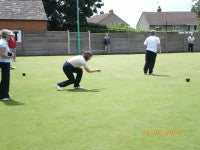 During the course of bowling green advisory work, one of the most common problems is that of slow and heavy bowling surfaces. Unfortunately, many bowlers still believe that the difficulty is a straight forward one which can be cured simply by very close mowing and repeated use of heavy rollers.
During the course of bowling green advisory work, one of the most common problems is that of slow and heavy bowling surfaces. Unfortunately, many bowlers still believe that the difficulty is a straight forward one which can be cured simply by very close mowing and repeated use of heavy rollers.
You may well get an immediate response to this activity, but improvements are short lived and the long term side effects of such actions can often be disastrous by weakening the plant and inducing compaction. That then builds up, hence the green is them producing slower running surfaces, particularly when wet.
Autumn renovation is key to reducing thatch compaction and improving the structure of the green. Therefore, the following sequence of operations is proven to be effective. The implementation of such key operations must be in association with conducive weather patterns.
The basic skills :-
Mowing - height of cut and frequency
Scarification - thatch control
Aeration - reduce compaction, create root room
Renovation - repair damage
Overseeding - mixture and equipment
Fertiliser - types and application
Top dressing - suitable quality and rates of application
After care - maintenance and schedule
Health and safety - performing all works correctly and safely
 Towards the end of August a slightly different approach may be needed. As the hours of daylight decrease and night time temperatures fall quite heavy dew may occur. In this event try to brush off the moisture each morning as doing so will reduce the risk of Fusarium patch disease.
Towards the end of August a slightly different approach may be needed. As the hours of daylight decrease and night time temperatures fall quite heavy dew may occur. In this event try to brush off the moisture each morning as doing so will reduce the risk of Fusarium patch disease.
From the onset of heavy dew until the night frosts begin, the turf is most susceptible to attack by this most damaging disease. If your green is in a location making disease a perennial problem it is advisable to spray a turf fungicide as a preventative measure.
This should be carried out from the middle of August to mid November as necessary. It is important that when using a systemic fungicide treatment is applied before the disease is evident or a least at the very first signs of it. It is, therefore, crucial that the green is monitored closely every day during this period for any sign of disease and that sufficient fungicide is always available.
 Fusarium patch disease is a very damaging disease in turf and can spread rapidly in the space of a few days. During cold conditions when there is little or no growth, an application of a contact acting fungicide should be considered. If the disease attack is observed a contact fungicide is best approach.
Fusarium patch disease is a very damaging disease in turf and can spread rapidly in the space of a few days. During cold conditions when there is little or no growth, an application of a contact acting fungicide should be considered. If the disease attack is observed a contact fungicide is best approach.
Autumn is a season of great importance with regard to maintenance operations. The regular playing fixtures come to an end, so preparation for the winter can begin.
The green should be thoroughly scarified in two diagonal directions in order to remove surplus growth and dead fibre (thatch). The resulting debris should be removed after each pass.
Scarifying can be done more quickly and effectively by using a machine such as a SISIS rotorake or Graden fitted with thatch removal blades which should be set to significant thatch depths ranging from1 to 2 cm.
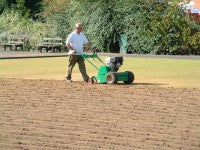 This should be followed by aeration to a depth of 10 to 15cm using solid tines.
This should be followed by aeration to a depth of 10 to 15cm using solid tines.
If compaction or thatch build up is particularly severe, the hollow tines should be used. If the thatch is as thick as your index finger then light scarification and solid tine aeration should be implemented. If the thatch is thicker than two fingers then more drastic measures such as hollow tining and greater scarification depth must be considered.
Now is the time to dress the green with Whitemoss Eco sand and organic dressing. This mixture is specifically designed for fine turf areas.
Ideally, the composition for such mixtures is around 70% sand to 30% soil (of the right particle size of around 0.25 and 0.50mm). No more than a 10% variance either way of this percentage is advisable.
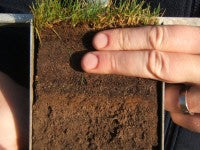 This work should be carried out when the surface is dry in order to maintain a true surface. At least 4 tonnes of material should be applied, possibly more if major scarification and aeration are implemented, i.e. bigger tines and slitting are made.
This work should be carried out when the surface is dry in order to maintain a true surface. At least 4 tonnes of material should be applied, possibly more if major scarification and aeration are implemented, i.e. bigger tines and slitting are made.
It is imperative that top dressings are thoroughly worked into the sward to avoid smothering the turf. The use of a SISIS trulute or drag mat and drag brush will assist here.
If any areas need re-seeding, this should be performed as soon as possible ensuring that the seed is lightly covered by the top dressing at all times. The green will still require cutting, however, to avoid picking up the top dressing the height of cut should be reset to 10mm. This setting may be used throughout the late autumn and early spring.
Mild moist conditions during the autumn is the ideal time to apply worm pest control as the worms are near the surface and are, therefore, more susceptible to these materials. Limited materials are now available in killing earthworms, hence the need for regular switching and brushing to dissipate the casts.
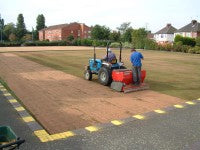 Fertilisers are available in varying formats. The regular use of salt based fertilisers is still the most common. They are applied to maintain health of the grass and appearance of the bowling green. It is also used to help assist in providing nutrition by which the plant may recover from stress.
Fertilisers are available in varying formats. The regular use of salt based fertilisers is still the most common. They are applied to maintain health of the grass and appearance of the bowling green. It is also used to help assist in providing nutrition by which the plant may recover from stress.
As with all turf surfaces, different nutrition levels are applied at different times of the year, e.g. spring and summer, more nitrogen is needed as the grass plants are actively growing; autumn and winter more phosphorus and potash are applied to encourage root development.
The best condition for the application of fertilisers are when the immediate surface is dry, but with moisture present within the soil profile. Dry, windy conditions are to be avoided which may result in an uneven distribution followed by scorching of the sward.
Fertiliser application must be always be followed by watering in one form or another.
Always check the calibration of any machine prior to an application in order to determine the correct rate at which the fertiliser should be introduced according to the makers' instructions.
Fertiliser distributors are used widely in turf culture for spreading fertilisers evenly and efficiently. Any distributor should be able to carry out the following functions :-
· Able to spread both granular and powder fertiliser at a wide range of application rates.
· The application rate should be easily adjustable.
· They should be adaptable to sow grass seed on lawns and apply top dressings also.
· They should be designed and built in a way that will reduce corrosion as far as possible.
Renovation and Repairs
 The whole surface should be checked for any irregularities. Worn areas will require repair and levels may be renovated. The use of turf is acceptable, but the opportunity of purchasing suitably turf would be minimal. It is possible that a club could have its own turf nursery for obtaining quality turf at the right specification to be compatible to the green. However, I have yet to see any club provide such a maintenance regime.
The whole surface should be checked for any irregularities. Worn areas will require repair and levels may be renovated. The use of turf is acceptable, but the opportunity of purchasing suitably turf would be minimal. It is possible that a club could have its own turf nursery for obtaining quality turf at the right specification to be compatible to the green. However, I have yet to see any club provide such a maintenance regime.
The choice of seed is regularly available, basically a mixture of standard greens mixture comprising of 80% Fescue and 20% Bent.
Maintenance
After the completion of the autumn work on the bowling green, many clubs have the opinion that the ground may be left unattended until the following April. This is far from the correct approach. The green keeper should aim to keep an eye on the greens at regular periods over the winter.
The occasional surveillance of the green will provide the opportunity of investigating any outbreaks of fungal disease and also enable the detection of any excessive grass growth.
In any mild spells it may be necessary to top the grass to ensure that the sward does not receive a check in the spring by removing too much growth in a short period of time. I see this fault regularly in the spring by ill informed, but keen operatives. Any growth over 18mm should be lowered to 12mm. Never cut any more than 1/3 off the length of leaf blade at any one cutting otherwise this will destruct the root development of the plant.
Walk the green to remove any debris or rubbish which may have accumulated to ensure that no damage will be caused to the machinery and equipment.
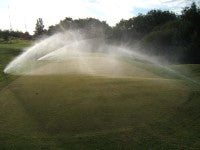 Bank faces may be renovated at the end of the playing season. Grass banks could suffer in drought conditions during the summer and may need re-turfing. Pre-fabricated banks should be checked to ensure that the striking boards are in good condition and replaced along with the battens.
Bank faces may be renovated at the end of the playing season. Grass banks could suffer in drought conditions during the summer and may need re-turfing. Pre-fabricated banks should be checked to ensure that the striking boards are in good condition and replaced along with the battens.
Surrounds, features such as paths, pavilions, benches and fences can be repaired and renovated during the winter months.
Any planted areas surrounding the green should be maintained to improve the aesthetic value of the area. Plants that are fairly close to the green may induce shade problems. Care should be taken to see if any judicious pruning will allow further light onto the green without destroying the plants.
Hedges should not be allowed to grow too high to the extent that they also induce shade problems or restrict air circulation.
Paths should be tidied and made ready for the following season. Ensure moss does not ingress and case a health and safety issue.
The irrigation system should be serviced regularly for the new season. It should be drained over winter and commissioned in April.
David H. Bates has followed the views detailed within this paper for over 30 years of service to the maintenance practices of turf management and is available for site visits and further advice. For further information visit our website www.davidhbatesagronomy.com or email DHBatesservices@aol.com
